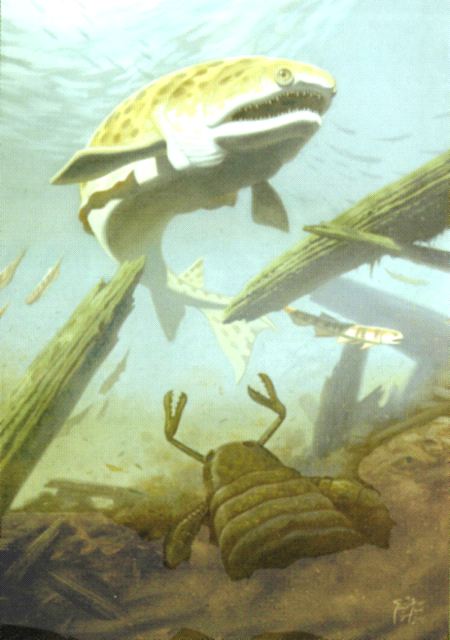Invertebrates
An invertebrate, as the name suggests, is an animal that cannot be categorized as a vertebrate.
 (40 kb) This might seem overly simplistic, but the animal kingdom is divided into far more than just two phylums. In fact, biologists have counted more than thirty, and only one of these is for vertebrates.
(40 kb) This might seem overly simplistic, but the animal kingdom is divided into far more than just two phylums. In fact, biologists have counted more than thirty, and only one of these is for vertebrates.
In Devonian time, “invertebrates” were mainly restricted to aquatic environments, with only a small number having conquered land. The primary aquatic habitat was marine, but a few rare species had recently adapted to freshwater lakes and rivers.
Surprisingly, the invertebrates of the fossil-rich Miguasha cliff display very little diversity. They represent only a third of the animal species recorded thus far, and are mostly arthropods. Some lived in an aquatic environment, whereas others lived on land.
Paleontologists have not yet finished documenting diversity of land dwelling arthropods at Miguasha, but known taxa are typical of the Devonian world. The low diversity of aquatic invertebrates at Miguasha is in stark contrast with the multitude of forms that filled the seas at that time. Such a limited number of aquatic species other than fish is attributed to a large influx of fresh water – large enough to have rendered this habitat unsuitable for most marine invertebrates.

 (40 kb) This might seem overly simplistic, but the animal kingdom is divided into far more than just two phylums. In fact, biologists have counted more than thirty, and only one of these is for vertebrates.
(40 kb) This might seem overly simplistic, but the animal kingdom is divided into far more than just two phylums. In fact, biologists have counted more than thirty, and only one of these is for vertebrates.In Devonian time, “invertebrates” were mainly restricted to aquatic environments, with only a small number having conquered land. The primary aquatic habitat was marine, but a few rare species had recently adapted to freshwater lakes and rivers.
Surprisingly, the invertebrates of the fossil-rich Miguasha cliff display very little diversity. They represent only a third of the animal species recorded thus far, and are mostly arthropods. Some lived in an aquatic environment, whereas others lived on land.
Paleontologists have not yet finished documenting diversity of land dwelling arthropods at Miguasha, but known taxa are typical of the Devonian world. The low diversity of aquatic invertebrates at Miguasha is in stark contrast with the multitude of forms that filled the seas at that time. Such a limited number of aquatic species other than fish is attributed to a large influx of fresh water – large enough to have rendered this habitat unsuitable for most marine invertebrates.
Site map | Feedback | Links | Sources | Credits
Invertebrates
<< Coprolites | The aquatic environment >>

Title: Few invertebrates, many fish!
Author: François Miville Deschènes
Sources: Parc national de Miguasha
Year: 2000
Description:
The eurypterida Pterygotus, a large sea scorpion, was one of the rare invertebrates of the ancient estuary of Miguasha. The waters of this estuary were overwhelmingly dominated by fish.


